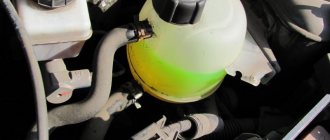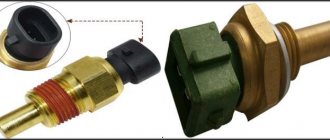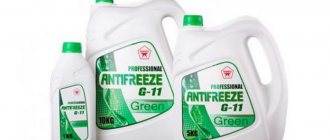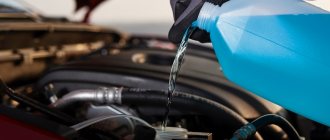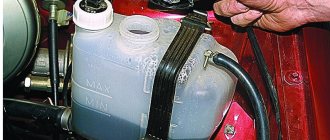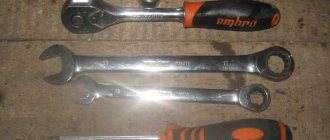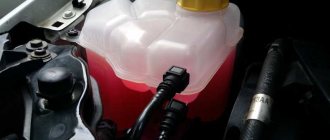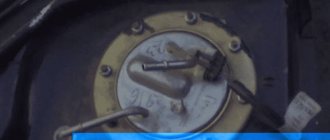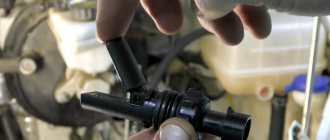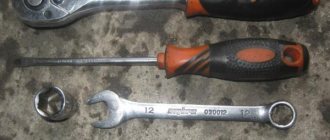Antifreeze, also known as coolant, plays a key role in the proper functioning of the car. Its main task, as the name suggests, is to cool the engine. If there is not enough antifreeze in the tank, there is a high risk that the car will overheat. This is fraught with many problems for the engine at once, so such a problem cannot be allowed. The driver is obliged to monitor the level of antifreeze in his car, and in this article we will look at how to do this correctly.
Toyota Allion 2008, petrol engine 1.l., 110 l. p., front wheel drive, CVT — scheduled maintenance
Chita
Toyota Allion, 2009
700 000 ₽
Chita
Toyota Allion, 2010
760 000 ₽
Vladivostok
Toyota Allion, 2015
930 000 ₽
Blagoveshchensk
Toyota Allion, 2009
690 000 ₽
See more cars on Drome
Participate in the discussion can only registered users.
Login Register
This is interesting: How much to pour into a VAZ 2109 box
Probable leak locations
Where can antifreeze go? It is still a liquid, so it can evaporate when heated. To make evaporation less intense, the tank or radiator is tightly closed with a lid. But complete blockage is also not allowed, so there are bypass valves in the lid.
They are needed to relieve pressure in the system if it has risen above the critical norm. It is through this valve that antifreeze evaporates, especially in the summer season. It is very hot in the summer, and if you drive in a traffic jam, the cooling system will not have time to fully remove heat from the engine; it will operate at an elevated temperature. In this case, the antifreeze heats up more than normal, part of it goes into a gaseous state (steam), increasing the pressure in the system, and when the pressure rises above normal, the steam will be released through the valve.
Antifreeze may also leak due to a leak in the system or a crack in one of the rubber pipes. Because of this, the coolant will simply leak out through a leak or crack. In this case, it is very easy to detect a leak - by drips on the pipes and traces of liquid on the asphalt under the car while parked.
The most unpleasant leak is due to a breakdown of the cylinder head gasket (cylinder head). As a result of the breakdown, the cooling system channel is connected to the cylinder, or the crack leads outward. It is very dangerous if a breakdown connects the channel to the cylinder. Not only will the liquid “fly out into the pipe” in the literal sense, but if the repair is untimely, a “water hammer” may occur due to the large amount of antifreeze in the cylinder, and this is already fraught with serious problems, since as a result of this effect the destruction of the piston is possible, connecting rod bend.
It is noteworthy that a cylinder head gasket failure is usually a consequence of engine overheating due to insufficient antifreeze.
Consequences of a cylinder head gasket failure
Errors when handling antifreeze and their consequences
When checking the antifreeze level in the tank, it often becomes necessary to top it up. In winter, it evaporates intensely, so you need to check its condition more often at this time. At low temperatures, all elements of the expansion tank partially lose their tightness, as the properties of rubber and plastic change. This is fraught with antifreeze leaks. As a rule, they are not fatal, but this does not eliminate the need to monitor the process and timely add a new portion of antifreeze.
Typical mistakes when handling antifreeze are:
- the plug is unscrewed “hot”, without waiting for the engine to cool down;
- there is no rag on the tank (if the tank has not had time to cool completely, this can be dangerous);
- fresh liquid is added “to the hot one;
- antifreeze is poured into an empty container;
- do not use distilled water, but ordinary water when topping up.
No matter what frivolous “experienced” drivers say, you cannot unscrew the cap when the engine is hot. Even if the brave souls are constantly lucky, it is not a fact that next time everything will be exactly the same. Since the pressure in a closed system is high, when you unscrew the cap “hot,” the liquid may splash out onto your hands or even onto your face. Serious burns always leave scars, so there is no need to rush and tempt fate.
There are situations when there is no time to wait until the system has completely cooled down. In this case, place a rag over the lid before unscrewing. It will close the drain hole and prevent a strong splash of antifreeze, but will not be able to protect against splashes. To avoid injury, it is better, however, to wait until the engine has completely cooled down and only then get to work.
What can be added and in what quantity?
There are several types of antifreeze. You cannot mix them with each other, but you must add them strictly according to the marks. There is an opinion among car enthusiasts that some types of coolants are compatible with each other in terms of their chemical composition, but it’s still not worth taking risks and mixing them. To avoid unpleasant situations and machine breakdowns, use one type of fluid and buy it from trusted manufacturers.
When adding any water (regular or distilled), antifreeze may freeze in winter. If there is no fresh portion of antifreeze, add water only in the warm season. Never dilute the coolant with other chemicals. As a last resort, use plain water, but do not overuse it.
On a note!
The lack of antifreeze in the tank can take the driver by surprise before the winter cold. To prevent this from happening, before the winter season, completely change the cooler and fill in a new one.
You need to spend time monitoring the condition of the coolant, otherwise it can be fraught with bad consequences for the car. If you check the antifreeze level in a timely manner, the engine will work properly, and the car will serve you for many years.
The need to check the coolant
How often should antifreeze be checked? It depends on what kind of car you have, how old it is and what its general technical condition is. If you do not check how much fluid is in the tank and do not top it up in a timely manner, engine problems are inevitable. During operation, the motor constantly heats up, especially in hot weather, and for normal operation it needs regular cooling.
The service life of your car's engine directly depends on the condition of the coolant.
Why you need to regularly monitor this process:
- antifreeze cools the engine, preventing it from overloading and breakdowns;
- its composition, circulating through a closed system, “extends the life” of the engine;
- external fluid leakage can lead to contaminated vehicle surfaces that are difficult to remove;
- internal leaks are dangerous: if antifreeze gets into the cylinders, this can cause water hammer and complete failure of the car engine.
Any antifreeze is a liquid with a characteristic odor and color. Thanks to its special chemical composition, it does not turn into ice at low temperatures and remains in the same state in any weather conditions.
What level of antifreeze should be in the radiator
The main mechanism of the cooling system is the radiator. In addition to this, this also includes a fan, water pump, thermostat, hoses, belts, sensors. The coordinated operation of the cooling system allows antifreeze to be directed around the cylinder head and valves. The coolant must pick up thermal energy and return it to the radiator, where it is dissipated. That is why it is necessary to know what the level of antifreeze in the radiator should be. After all, if there is not enough antifreeze, you should add the missing volume as soon as possible.
What should be the level of antifreeze in the radiator and how to determine it?
- Park the car on level asphalt.
It is best to check after traveling a short distance. Without waiting until the engine has completely cooled down, check the antifreeze level. If the car has been driven long enough, you should wait 2-3 hours for it to cool down.You cannot check the antifreeze level if the engine is not turned off. You should not perform diagnostics if the engine has not yet cooled down.
- Open the hood.
- Inspect the radiator cap.
It should be at the top of the radiator under pressure. If the car is new, you will notice the cap will be marked. Otherwise, you must study the car's owner's manual to find the cap.We recommend
“Which antifreeze to choose: TOP-11 rating” Read more
- Remove the lid using a cloth to avoid getting burned .
The fact is that antifreeze takes thermal energy from the engine, and part of it is transferred to the radiator and covers. The fabric will protect your hands so you don't get burned. - Check the antifreeze level.
What should the antifreeze level be? Ideally, the mark should be in the top position. When there is an antifreeze level marking on the radiator, this will help you better navigate.
- Find the cap on the antifreeze overflow tank, then remove it .
The coolant in modern cars should be located not only in the radiator tank, but also in the intermediate tank. It is necessary to supply antifreeze if the engine gets very hot. Typically there is not a lot of coolant in such a reservoir. It also happens that the level of antifreeze in the radiator is minimal, while almost all the coolant is in the overflow tank after the car has been broken in. If you notice this symptom, you should immediately call a tow truck and go to a service station. - Check the freezing point and boiling point of antifreeze .
After prolonged use, the coolant loses some of its properties; it absorbs and dissipates thermal energy worse, which means the engine is not cooled as efficiently. Measurements can be taken using a special hydrometer. - Add antifreeze if necessary .
Your car most likely has an overflow tank; you can add antifreeze into it. It can also be added to a radiator. To make it more convenient, use a funnel, because you should not spill coolant. Typically, antifreeze is mixed with purified water in a 1:1 ratio. If you operate a car in harsh climates, then the ratio should be: 7 parts antifreeze and 3 parts water. The concentration should not be greater! Antifreeze should be added when the engine has completely cooled down.
How to check correctly?
Now about how to check the antifreeze level.
Cooling systems in different cars are slightly different; some have an expansion tank that controls the level, while others do not. In cars whose cooling system includes this reservoir, checking the level is very simple. The tank is usually made of light plastic, and the antifreeze has a certain color. There are also marks on the tank wall indicating the minimum and maximum levels. Therefore, to check the fluid level, you don’t even need to unscrew the cap; you just need to look at the level on the wall of the tank and compare it with the marks.
In cars whose cooling system does not include a tank, topping up and level control is done through the neck located on the radiator. That is, we unscrew the radiator cap and look at the level.
Now some features of the test. It is performed only on a cold and idle engine, for a number of reasons. When heated, antifreeze expands, so when monitoring the level in the tank, the quantity data will be incorrect.
As for cars in which the fluid is checked in the radiator, checking when the engine is hot can lead to injury. The fact is that after heating, pressure forms in the system, and if you remove the radiator cap, there is a high probability of hot antifreeze splashing out through the neck, so it is very easy to get burned. It is best to check the level in the morning, before the trip. The engine will cool down completely overnight, and the level readings will be most accurate.
What determines the volume of coolant in the system?
The volume of coolant in the circuit depends directly on its temperature and weather conditions. In the hot season, as a rule, the coolant in the expansion tank will always be close to the MAX mark, while in winter it can be seen at the MIN mark. This is explained by the change in the volume of the liquid depending on its temperature: the colder it is, the less V.
This is interesting: Is it possible to mix antifreeze with water in the summer?
Process:
1. Before every trip, you need to check the coolant level. To do this, look at the wall of the expansion tank. If the fluid level is below the min mark, it means the coolant needs to be added. 2. Many cars are equipped with a coolant level monitoring system, which indicates a low coolant level in the system by lighting up a light on the instrument panel. 3. You can check the coolant in the radiator in the following way. 4. Remove the radiator cap. If the radiator cap has a pressure release system, then lift the release lever before opening and the pressure in the radiator will drop. 5. Then take the lid with your hand through a rag so as not to get burned, unscrew it and remove the lid so that it opens away from you in the other direction. 6. It is possible that steam will escape from the radiator when you open the cap; in this case, you should screw the cap back on and wait until the radiator has completely cooled down. 7. It is best to check the coolant level before starting the car, when the engine is cold.
It is necessary to check the coolant level once a month.
Is it possible to mix different antifreezes?
Due to the huge range of coolants, car enthusiasts are increasingly mixing two or three incompatible substances. In this case, the output is a strange-colored liquid with sediment or foam; often the “frieze” turns into an emulsion. In general, the consequences of such mixing are extremely disastrous. If you are going to mix different refrigerants, you should clearly understand their compatibility.
